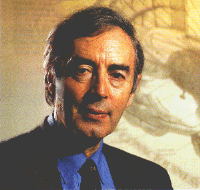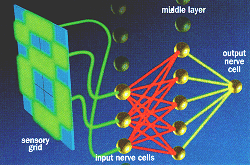
Science |
An adventurer in the big questions of science
 |
John Taylor, scientist, actor, broadcaster, is a true renaissance
man. He has experimented on Uri
Geller and criticised the ideas of Stephen
Hawking. Now he may be close to solving a great mystery: the
workings of our human consciousness
Professor John Taylor is that unusual animal: a scientist who thinks big. In a lifetime devoted to scientific research he has never been afraid to square up to the great questions - from the origin of the universe to the nature of our conscious minds. Along the way he's courted controversy and risked ridicule, most notably for his investigations of spoon bending and other paranormal phenomena.
|
When the paranormal was put to the test |
|
|
|
Twenty
years ago Taylor appeared on a TV programme on which Uri Geller
performed extraordinary feats of spoon bending and mind reading.
Taylor was impressed. To the dismay of other scientists, he
invited Geller to his lab, with others who claimed paranormal
powers such as dowsing and faith healing. If there were unknown
forces at work, he reasoned, they should be amenable to
experimental measurement. He abandoned the research after two years - the phenomena could not be relied on to appear in the lab. "Anything unusual could be explained in simple physical terms. When we used highly controlled conditions, using videos and devices to monitor muscle activity, nothing would happen - and I saw cheating." Geller made one visit to the lab and was unable to perform any of his tricks. Despite an open invitation to return, he never did. Does Taylor think Geller was a fraud? "I can't say. I'm afraid I was not privy to the setting up of his apparatus on the original TV programme. So, while I was originally a little disturbed that science may not be able to explain these phenomena, I cannot say what happened." |
| Uri Geller fails to bend the rules The sensational spoon- bender turned up, failed some scientific tests, and refused to come back to the lab |
|
For over 20 years Taylor has been Professor of Mathematics at King's
College, London. But the title belies the breadth of his interests. He
trained as a physicist and spent much of his career in conventional
research, investigating the fundamental properties of matter, from quarks
to black holes. But he's long nurtured a deep interest in the workings of
the brain, which have now become the centre- piece of his investigations.
The team that Taylor has assembled at King's is studying some of the most
far-reaching ideas to emerge from so-called neural networks: computer
simulations of simple networks of nerve cells in the human brain. Part of
the excitement over "neural nets" is that, unlike normal computers, they
have the ability to learn from experience. Although grossly simple
compared with even the brain of an insect, neural nets are good at
interpreting information and recognising patterns. They have found
applications in "intelligent machines", including airport security
scanners and voice- recognition systems. Taylor believes he's close to
unlocking the secrets of the conscious mind itself. Some people might
regard such a claim as speculative folly. After all, the problem of
understanding human consciousness the ability to be aware of pain,
pleasure, thoughts, visual images, our existence - has been the holy grail
of scientists and philosophers for centuries. Taylor has an advantage over
many of his colleagues. In addition to his formidable intellect, he
delivers his message with charisma - not a word often used to describe
scientists. His charm and deep, mellifluous voice have made him a
favourite among broadcasters, and he has written several books on popular
science. Experience in theatre has helped too. He trained as a method
actor in America, where he gained a Screen Actors Guild card and appeared
in plays on Broadway. In the Seventies he wrote and adapted a number of
plays. set up a drama society at Churchill College, Cambridge (called The
Gods), and ran a drama group in Soho. In fact, one suspects that had
Taylor not been so interested in the brain and the universe he would now
be an impresario like Peter Hall or Jonathan Miller. But impresarios tend
to have strong opinions, and sometimes strong opinions can lead to
trouble. There's a famous anecdote about Taylor which over the years seems
to have been blown out of all proportion. It concerns the time around
Christmas 1973 when a young Stephen Hawking unveiled new ideas about how
black holes could radiate energy. This was certainly radical stuff,
because until then everyone had thought black holes were perfectly black,
so that no matter at all could escape their clutches. According to the
biography of Hawking by Michael White and John Gribbin, as soon as the
lecture was over Taylor jumped up and proclaimed that what Hawking had
said was complete nonsense. Pausing only to drag one of his colleagues
from the seat beside him, Taylor stormed from the room and immediately
started writing a paper denouncing Hawking's claim." Taylor (and other
witnesses) insist this version of events is inaccurate: Taylor did not
denounce the idea of black hole radiation per se, but said he disbelieved
Hawking's explanation of it. "That's the purpose of science: to have
scientific debate and bring out into the open where things aren't proven.
Stephen's explanation at the time was a conjecture, and I was merely
expressing doubt over it. "I'm happy to say I was wrong to judge him at
that point. But he's been proved wrong on other things. He claimed "N=8
super- gravity" was going to be the unified theory of everything; we found
later that it wasn't." N=8 supergravity was a theory popular in the 1980s
among mathematicians and physicists who believed it would unify all the
forces of nature. But it had major problems, and was succeeded by another
theory - superstrings. This is still the leading candidate for a "theory
of everything". In superstring theory, the ultimate building blocks
of matter are regarded as string- like objects. The string-like nature of
fundamental particles like electrons and quarks - once thought of as
point-like - has not been proved. But if true, it has immense implications
for the nature of forces and matter. Taylor worked in this area for a
while and still contributes papers on the subject, but about ten years ago
he began to be attracted by new possibilities opening up in brain science.
The development of scanners and other probes into the brain offered major
new insights. At the same time. powerful desk- top PCs were making it
possible to study aspects of the brain using silicon hardware rather than
organic "wetware".
 |
| Modelling the mind Taylor models aspects of the brain using neural networks - interconnected nerve cells simulated on a computer.This three-layer "net" is a simple example. It can be trained - in this case ,to recognise certain numbers. Here "8" stimulates the input cells;their message is processed by the middle layer.If the output is a correct response (ie if it recognises the right numbers),certain connections between cells are strengthened or weakened. After repeating training,the responses will eventually be correct. |
Since then Taylor has immersed himself in the study of neural networks and in ways of modelling the brain. And unlike most other scientists working in this area, who usually come from biological disciplines, he's been able to apply powerful mathematical principles normally found only in advanced physics. In his quest to understand consciousness, Taylor has identified a part of the brain that is of particular interest, the "nucleus reticularis thalami".
This is a sheet of nerve cells that seems to act as gatekeeper for signals in and out of the cerebral cortex, the thinking part of the brain. Using neural nets Taylor has studied some of its properties. In his models, neural activities compete against one another and the winner takes all. Taylor believes that a similar activity happens in the brain. "Various neural activities emerge from different parts of our working memories and jostle for supremacy. When the competition is over, the winner broadcasts its message all over the cortex. The result is a conscious thought." This could be the explanation for what's known as the stream of consciousness - that it's the result of repeated battles inside the nucleus reticularis thalami. So confident is Taylor about the success of neural net modellers, he's predicting that one day we will be able to go into Dixons and buy a "conscious robot kit". But how long will we have to wait? "At the outside, 100 years. At the inside, I just don't know. The principle may be understood sooner than the practice. It may take a while for industrial consortia to think it's worthwhile. At the moment they're more into neuro-fuzzy cooking machines and neuro-fuzzy washing machines than conscious machines!" Taylor's latest book, When the Clock Struck Zero, connects the consciousness issue with the other big questions of science. It is in two halves, the first dealing with the physical universe, the second the mental universe. But while he thinks the enigma of consciousness may soon be cracked, the question of why the universe exists, he argues, is forever beyond us. He envisages an infinite sequence of theories of the universe - starting with Newton, followed by Einstein, super- strings, and so on and on. "Each theory will be an improvement on the previous one, but we'll never reach the end." Although this seems to endow the universe with a transcendental quality, Taylor is totally against seeking meaning through religion. "The universe has no meaning. We're all part and parcel of it, but you won't find meaning through prayer or other forms of meditation. Or at least if you do, it's an illusion. "There are no other ways to knowledge than through science. Yet science has an infinite amount to tell us. The take- home message is that if you want to find meaning in your life, live it for a certain amount of enjoyment. We're only here for a rather short period of time, so try to enjoy it while you can."
When the Clock Struck Zero is out in paperback in June published at
£6.99 by Picador
Julian Brown.